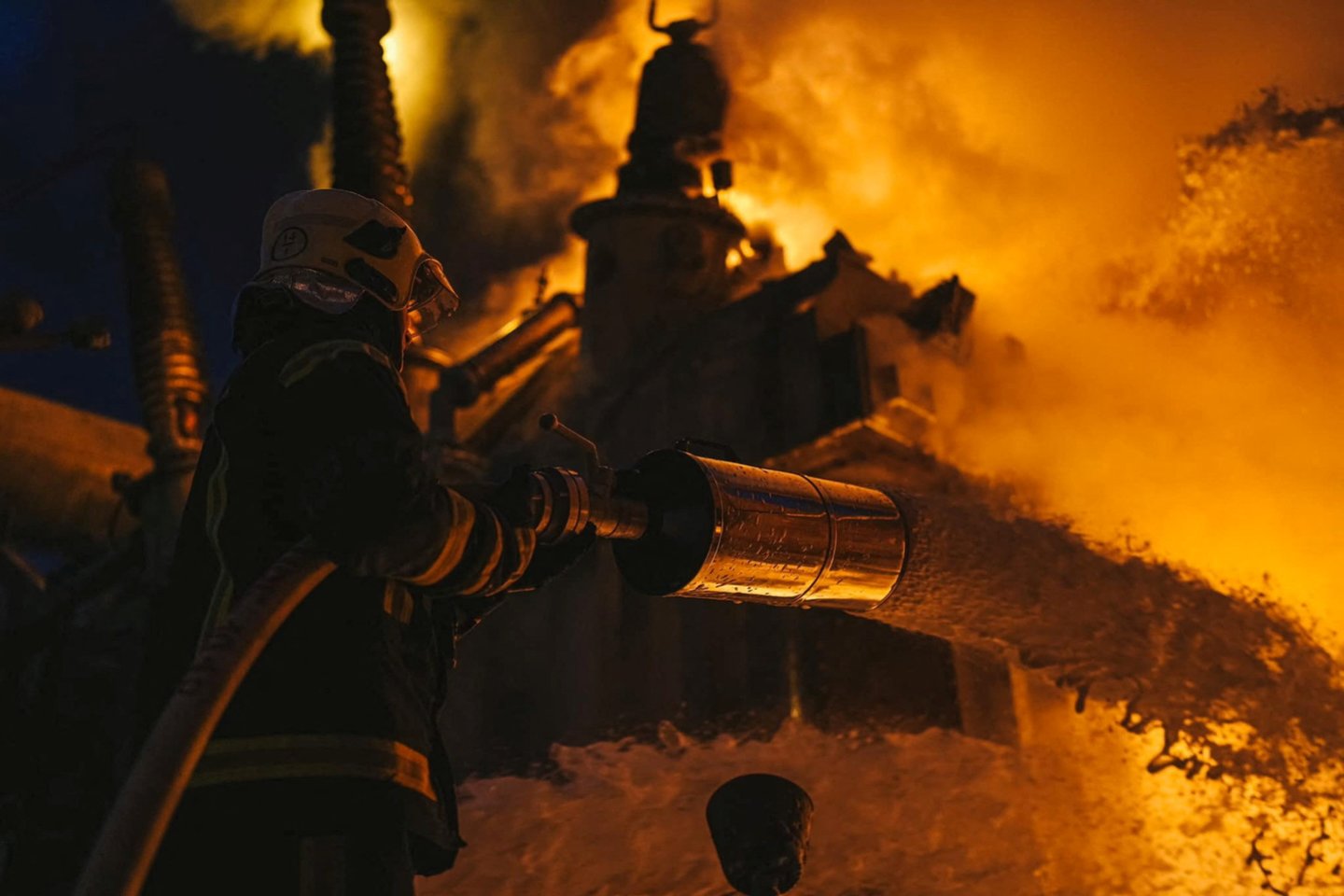According to Herman Halushchenko, Ukraine's Minister of Energy, "as of December 13, the situation with the energy system remains complicated. Russian missiles damaged all thermal power plants, and 44 high-voltage air transmission lines are without power", he stated. "Due to the current situation with the energy system, the deficit will likely remain during the entire winter season. The cause of the deficit is large-scale Russian attacks on the Ukrainian energy system. In addition, the repair works of the power system became harder when temperatures fell below zero", he added.
During a mass launch of missiles Russian Federation releases from 30 to 90 units in order to exhaust Ukrainian air defence. Regardless of that, the Ukrainian missile defence system makes the impossible, shooting down up to 90% of Russian rockets, using mainly outdated Soviet equipment. Still, some of them achieve their "targets".
We managed to visit a highly vital military object, namely the location of the S-300 missile system battalion, which is protecting the sky over part of Kyiv.
Nasty wet snow is drizzling. A small village somewhere in the depth of the Kyiv region. Nearby the closed local post office, there is a dirty, camouflaged SUV (sport utility vehicle). We spotted several military men staying next to the car, smoking cigarettes and producing big puffs of smoke. These are the very same people all Ukrainians lately have been praying for. Those soldiers belong to the anti-aircraft missile troops, who are the ones to ensure the protection of Ukrainian territory from Russian missiles and Iranian drones. Yevgen (nickname "Vegan") greeted us and informed us that we had to ride another dozen of kilometres off-road to get to the direct location of the anti-aircraft missile troops' military base.
Few words about the unit's combat path
Frankly speaking, there was nothing to indicate that the place we came to was somehow related to the military. The whole territory was covered with a camouflaged net. Only the sound of a diesel-powered generator and the smell of the field kitchen made it seem like there were people. Yevgen invited us for breakfast in the improvised canteen. The officer told us that at the beginning of the full-scale invasion on February 24, the Russians managed to destroy several launchers of the S-300 missile system of this division. It was indeed a hard time for the unit. However, because the team started manoeuvring, the majority of the launchers were saved.
Anyway, the Russians failed to destroy this anti-aircraft battalion entirely. Later on, they paid for it. After recovering, Ukrainian soldiers began to shoot down Russian military aircraft.
Russian missiles' attack
Our conversation was interrupted by the sudden air raid siren. Yevgen's subordinate ran into the canteen. He informed that according to the Ukrainian intelligence data, Russians launched cruise missiles from the ships in the Black Sea. Yevgen immediately started moving and told me to go to the command bunker asap. Inside a big concrete building, there was a slightly chaotic atmosphere. But as it turned out later, it was quite a misleading impression. It was controlled chaos. Ukrainian soldiers did not fix Russian missiles on their radars but were already actively processing the information from their colleagues in the South of Ukraine.
Since that is where the first outpost of the Ukrainian air defence is situated, and it is the anti-aircraft troops from the Operational Command South who are supposed to be the first to shoot down Russian missiles. But Russians have changed their tactics and now launch many missiles simultaneously from different places. Therefore, it is getting harder for Ukrainian soldiers to shoot down all the missiles.
One of the military men shouted to the whole bunker, "message from the South: 2 targets done, three missiles, unfortunately, are flying to our sector". The commander of the battalion loudly expressed himself. It became clear to everyone that the main pressure would not fall on this battalion.
There was total ominous silence in the bunker for a couple of seconds. But not for long. The voice of another military man withdrew everyone out of the stupor state. With a very clear tone, he informed everyone: "in 10 minutes, missiles would be within our zone of responsibility". And then again, everyone started rushing around. The constant analysis of information from different radars was being made. Finally, the information about the first missile entering the battalion's zone of responsibility was sounded. Commander removed its cap, wiped his forehead, and peacefully said: "track the missile on radar, calculate the optimal interception point, and prepare the launcher for a salvo". Via the handheld transceiver (HT), it was informed that the missiles were ready to be launched. Commander asked if there were any deviations fixed from their predicted trajectory. His subordinate replied that there were no changes. Commander took the HT and pronounced "salvo on the set goals".
After a few moments two small explosions were heard. These missiles flew out of the launching system for interception. In the bunker, everyone stood up to the radar, where it was possible to watch as the rockets flew. At a distance of about 30 km away from us, one of the Ukrainian missiles caught up with the Russian one and exploded next to it. Its striking elements hit the Russian rocket and made it detonate. Another Ukrainian missile had the self-destruct mode activated. Despite their significant success, the Ukrainian military continued to work hard, as there were still 2 Russian missiles in the sky.
"Azimuth – 95, distance – 70300, the target is rapidly approaching"- could be heard at the command post of the S-300 anti-aircraft missile troops battalion. The commander leaned over the screen, where the soldier was making some calculations. Commander again gives the order to follow the target and prove the immutability of its trajectory. One of the subordinates started calculating the coordinates of where the Ukrainian missile should intercept the Russian one.
At the moment, at the command post, information was voiced that another Russian missile had changed its trajectory and moved in the direction of Zhytomyr. It meant that one missile was left to shoot down. The point of missile interception was already calculated, and Ukrainian missiles were promptly flying up into the sky. After a few seconds, a sound of a powerful explosion could have been heard. The remains of the Russian rocket fell down in the field relatively close.
Unfortunately, not all of the missiles and drones launched by Russia end up being shot down by Ukrainian anti-aircraft troops. For example, on the night of December 10, Russia carried out a massive strike with the use of Iranian UAVs on the energy infrastructure in the Odesa region, resulting in Odesa living without electricity, heat, and water supply for more than 30 hours. According to energy experts, a stable electricity supply to the city will become possible only in the spring. Currently, more than 1.5 million people in the Odesa region remain without electricity.
Powerful artillery strikes are also carried out on Mykolaiv and Kherson. In fact, a week after the Russians fled from Kherson, they began to attack the city and its infrastructure systematically. Important to note that Russia is also striking Ukraine with S-300 missiles, which pose an increased danger to ordinary civilians because Russia has a huge number of charges for them and is shelling the border settlements of Ukraine without control.
Thus, Russia combines massive missile strikes and shelling with the help of artillery and MLRS. Russia deliberately inflicts the most massive strikes during severe frosts: this tactic was adopted by Putin personally in order to cause the greatest possible damage and suffering to the civilian population of Ukraine. Why? To undermine their ability to fight back.
On Wednesday, December 14, Kyiv experienced another shelling carried out by the Russian army with Iranian-made Shahid drones with the Russian marking "Heran-2". The air alert in the city began at 5:55 a.m. and lasted until 9:07 a.m. In total, two waves of attack were inflicted on Kyiv. Thanks to the practical work of air defence and electronic warfare units, the Kyiv City Military Administration reported all 13 out of 13 UAVs launched by the enemy were shot down.
Several buildings in the city were damaged by shrapnel from enemy drones.
Battalion fighters admit that the equipment they work on is outdated and sometimes even refuse to work. There were cases when the missile simply did not fly out of the launcher or flew in the opposite direction from the target and ultimately had to be destroyed. Ukraine needs new and modern military equipment because the Soviet one runs out of its last capacities. Therefore, Ukraine needs accelerated deliveries of Western weapons, namely anti-missile and air defence equipment, tanks, artillery, and MLRS. Whatever it takes, Ukraine must survive this winter and defend its independence and sovereignty, which is infringed upon by the largest totalitarian state of our time.

